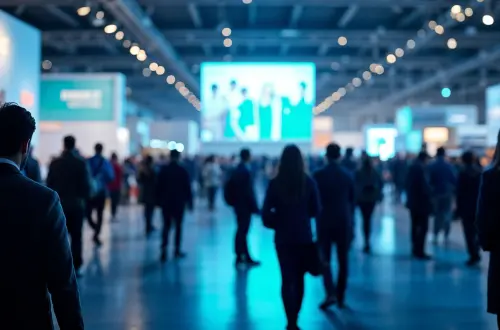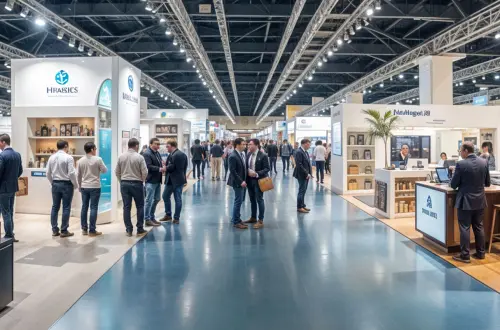Tire Technology Expo 2022 – A Symbol of the Tire Manufacturing Industry’s Successful Restart
Tire Technology Expo 2022 took place between 18.05.2022 and 20.05.2022 at Deutsche Messe. The hosting format of the event was face-to-face, amidst the absence of Covid-19 safety measures. It featured three central themes. It featured around 189 exhibitors from approximately 31 countries.
Deutsche Messe served as the hosting location for the Tire Technology Expo 2022. The event took place amidst the absence of obligatory Covid-19 safety measures. This was due to the country removing its domestic restrictions in April 2022. As a result, limitations were removed or reorganised into voluntary recommendations. This included the mask obligation and the social distancing policy. Organisers advised attendees to carry a surgical or FFP2 mask. This was necessary for situations where exhibitors might request them to wear one. Likewise, they were encouraged to maintain a safe distance of 1.5 metres. Deutsche Messe also advised participants to follow hygiene recommendations. Such included avoiding handshakes and following sneezing etiquette. The venue featured frequent disinfection sessions and emphasised high-touch surfaces such as bannisters. All exhibition halls, conference areas and entrances received a continuous external air supply.
Tire Technology Expo 2022 featured many sub-events that represented three themes. The central themes were sustainability, digitalisation, and global tire industry changes and innovations. The representation of the main topics occurred through various means. For instance, many of the conference sessions featured them as the principal subjects. The Awards featured them as part of the category criteria.
One highlight of the event was the Tire Technology Conference. It featured many highlight sessions and key presenters. Among the leading speakers were Jukka Antila and Frederic Biesse. They also included Jorge Lacayo-Pineda. The Conference consisted of sessions, each divided into lectures. Each seminar featured at least one speaker and, in many instances, a moderator. Among the highlights were:
- Opening Plenary Session
- GDSO eases tire data exchanges and enables new connected services (Speaker: Riccardo Giovannotti)
- Predicting tire tread wear resistance using laboratory test settings (Hiroshi Mouri)
- Recent developments in rubber rheology by advanced RPA testing (Dr Jorge Lacayo-Pineda)
- Long-term sustainability policy (Bernd Löwenhaupt)
- The Tire Industry's Changing Face
- Global tire industry outlook (Robert Simmons)
- Transformation of the international tire industry (David Shaw)
- The future of the tire industry, including M&A (Jacob Peled)
- Pyrolysis, recycled materials, and sustainability
- The ecosystem and tires (Frederic Biesse)
- Synthetic and natural rubber sustainability and greenhouse gas certification (Jan Henke)
- Circular economy: integrating sustainable materials within the production process (Guido Veit)
- Tire recycling on a global scale in 2022 (Martin von Wolfersdorff)
- Promoting sustainability: SDG roadmap on hastening impact within the tire sector (Ana Maria Arce)
- Going green by using sustainable and circular raw resources (Malte Wohlfahrt)
- Using tire pyrolysis oil for sustainable carbon black production (Robert Weibold)
- Leveraging Emerging Technologies in Tire Manufacturing
- Return of investment thanks to digitalisation strategy (Gian Paolo Di Salvo)
- Sensor fusion as a competitive advantage— intelligent vehicle diagnostics (Olle Hynen-Ulfsjöö)
- Tire laser marking (Dr Hartwig Suhr)
- Tire Development Using Machine Learning and Artificial Intelligence
- AI-based software for optical tire quality control and inspection (Frank Weber)
- Classification and visual inspection of tire defects through deep learning (Troy Anenson)
- Machine learning in forecasting tire failure (Piyush Ghongade)
- The automated tire plant: using AI to automate and promote autonomy (John Woods)
- Analysis of rubber compounding experimental design and machine learning (Hans-Joachim Graf)
- Automation, IoT, Digitisation, and Industry 4.0
- Path to automation in tire logistics (Jörn von der Lippe)
- Intelligent flexibility (Paolo Gamarino)
- Sensorik 4.0: can artificial intelligence address the new environmental challenges? (Andreas Morbitzer)
- Automated high bay warehousing solution without pallets for finished tires (Tony Leikas)
- Rubber development automation (Khaled Boqaileh)
- Application overview of tire industry laser processing (Florian Schreiber)
- Tire industry innovation – small chemical weighing (Guido Fona)
- Industry 4.0 applied to rubber compounding mixer gearboxes (Manex Berzosa)
The Tire Technology International Awards were also a highlight of the fair. They consisted of seven categories:
- Tire Manufacturing Innovation of the Year Award
- Environmental Achievement of the Year Award
- Tire Technology of the Year Award
- Tire Industry Supplier of the Year Award
- Tire Manufacturer of the Year Award
- Young Scientist Award
- Lifetime Achievement Award
Bekaert won the Tire Manufacturing Innovation of the Year award. They earned recognition for their BeCoFree - an innovative tire cord coating. It enables tire manufacturers to produce high-performance tires without using cobalt. Arlanxeo, Bridgestone, and Solvay earned the Environmental Achievement Award. Their collaboration resulted in creating TechSyn - a tire technology platform. It blends chemically streamlined synthetic rubber with tailor-made silica at a molecular level. This helps to deliver highly improved performance with less usage of materials. SRI received the Tire Technology Award for its Hydrogenated Styrene-Butadiene Rubber. This was due to the jury being impressed by the advanced research used to create the ware. The studies included the usage of synchrotron and super-computing facilities.
The jury granted the Tire Industry Supplier of the Year Award to Mesnac. The supplier received the award for its willingness to invest in innovations. Another cause was their willingness to adapt their products to the needs of the industry. Continental one again earned the Tire Manufacturer of the Year Award. The cause was their contribution to creating safe, sustainable, and cost-effective mobility networks.
The judging panel granted the Young Scientist Award to Marco Furlan-Tassara. They presented the lecture “Real-time friction estimation using neural networks”. The presentation was appealing because of various causes, including its compelling content. The reasons also include its practical approach and the smooth presentation delivery. Bo Persson received the Lifetime Achievement Award for their research in several fields. These include friction, adhesion, and tribology.
Tire Technology Expo 2022 featured many innovation highlights. This was due to the exhibitors exploiting the hiatus to research novel technologies. Among the highlights were the following:
- Maintenance-reducing ultrasonic tire cutting technology
It consists of an ultrasonic tire cutting machine with a special-designed cutting tool. The tool can vibrate 20,000 times per second. Additionally, the product performs gentle and angled micro-cuts during the production of tires. As a result, it extends the tooling lifespan to over two years. This also promotes cost reduction due to the tool needing fewer replacements.
- A compound-degradation-reducing nano filament-based carbon black alternative material
The novel structure is easy to process and has durability. As a result, the compound can perform at an optimal level. This includes new opportunities for combining properties. This promoted novel design possibilities. In particular, it enables high performance and sustainability when used in tread compounds. Among the features of the innovation were the pore structures within the aggregates. They are large enough to enable the penetration of polymers. As a result, the compound promotes better polymer/filler interaction and end properties. The innovation also includes micro-size ranged aggregates. These provide greater processibility to prevent small agglomerations from increasing mixture viscosity. Due to all the implemented features, the product can undo the “magic triangle”. Such includes improving the abrasion, grip, and rolling resistance. Additionally, it promotes the sustainability of ICE and EV tires during the use phase.
- Energy-efficiency-increasing pneumatic conveying production line system
The innovation consists of a dense phase pneumatic conveying system with Air Assist. It uses less compressed air compared to other similar products. This allows it to convey large quantities of raw materials such as carbon black with less effort. The device comprises a pipeline that has air injection orifices in strategic locations. These are used to convey scheduled product slugs. This allows for the movement of materials into storage silos at the beginning of the process. The Air Assist technology enables the control of the air pressure, rate, and speed. As a result, users can move fragile or abrasive products at slow speeds. This reduces material clogging up situation chances. It furthermore prevents issues such as high-pressure line problems. The preventable challenges also include conveying phase control inability. They further feature high final air expansion that can cause products to be damaged.
Tire Technology Expo 2022 marked the successful restart of the tire manufacturing industry. It featured approximately 189 exhibitors from around 31 exhibitor countries. Among the features lauded by attendees was the high quality of the visitor group.


